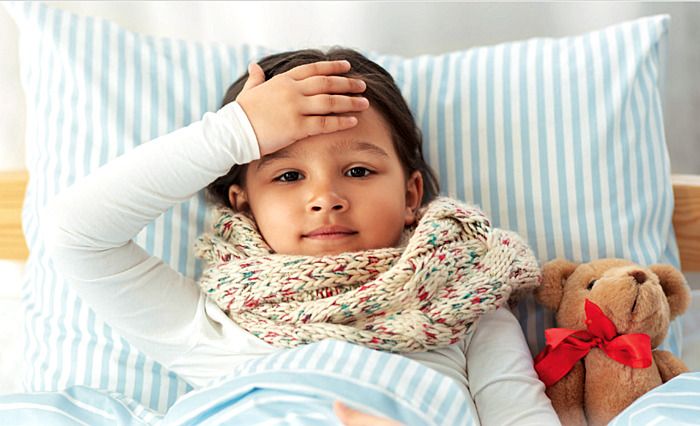What are children’s diseases?
Childhood diseases are contagious diseases caused by viruses or bacteria. They proceed like all infectious diseases. After infection, the virus or bacterium develops for a certain period of time without any symptoms of illness appearing. This so-called incubation period can last a few days or even several weeks before the disease manifests itself. Childhood illnesses are often accompanied by fever and a rash, but the exact symptoms vary depending on the illness. Most childhood illnesses have in common that you can only get them once, or not at all if you are vaccinated. The only exceptions are scarlet fever and whooping cough.
What can you do?
There is no treatment for childhood illness. Your doctor can only identify the disease and prescribe medicines to relieve the symptoms: medicines that relieve fever, pain or itching, or those that make it easier to breathe … In addition, measures can be taken to prevent any complications. Childhood diseases such as measles and mumps can be associated with complications that can lead to permanent damage.
Can a child disease be serious
Most are harmless, but some can have serious consequences, for example, whooping cough in infants and polio. Therefore, vaccination against polio is legally obligatory, and whooping cough is one of the vaccinations recommended for children under 2 years of age.
Can you avoid these diseases?
Fortunately, many childhood diseases can be avoided thanks to vaccination. A vaccination contains parts of weakened or dead microorganisms against which the body will produce antibodies. Thus, the child is immunized against the disease without getting it. Vaccinations protect it from the most dangerous childhood diseases such as whooping cough, measles, rubella and mumps.
Are childhood diseases contagious?
For adults, there is usually no danger. They are usually already immune to these diseases. However, there are exceptions, for example, rubella, which is especially dangerous for babies in the womb. Therefore, pregnant women who do not have antibodies against rubella or who have not been vaccinated against this disease must stay away from children with rubella at least during the first half of their pregnancy. Chickenpox can also have serious consequences for an unborn child if pregnant women contract it. When a child gets a childhood disease, the chances of his or her siblings catching it are high unless they are vaccinated. Often, infection occurs even before the disease becomes noticeable. People who are particularly susceptible or weak should stay away from sick children. Your doctor will advise you on the measures to be taken. Children cannot go to school or daycare during illness, even if they do not (or no longer) feel really sick. They could cause real small epidemics. Their immune system may also be temporarily weakened, which can make them more susceptible to other infections.
Do I need to see a doctor?
Yes, because the diagnosis is not always easy. You need to know exactly what the disease is and what measures need to be taken to avoid any complications. In addition, your doctor or pharmacist can advise you on the medication to administer to relieve symptoms such as fever or itching.
The eight most important children’s diseases
Important note
Vaccinations exist against most of these diseases. Thanks to them, polio, whooping cough, mumps, rubella, measles and chickenpox are among the preventable diseases. Get advice from your pediatrician! You can find out more about the Swiss Vaccination Plan on the website www.infovac.ch. It was written in collaboration with the Federal Office of Public Health (FOPH) and Swissmedic by the Federal Commission for Immunization Questions (EKIF), which consists of pediatricians, general practitioners, internists and specialists in infectious diseases, epidemiology and public health.
MEASELS
Risk of infection: the infectivity of a sick person exists three to five days before the onset of the rash and up to four days afterwards.
Measles is transmitted as follows:
• By droplet transmission, i.e. droplets from the nose, throat and mouth spread through the air.
• By direct contact with the (nasal) mucus or saliva.
• Sometimes through contaminated objects or surfaces.
Symptoms of the disease: the disease starts like a cold: fever, red eyes, runny nose, cough… Then the child seems to be better again, but dark red spots appear, first behind the ears, then on the face and upper body, sometimes accompanied by mild itching. The fever can rise to 40 °C and the child feels very bad. The disease lasts about two weeks and then disappears.
What to do?
Always consult your doctor and follow his instructions. If the child’s condition does not improve after the rash disappears, consult your doctor again. The child cannot return to school until he/she has fully recovered.
CHICKENPOX (Varizellen)
Pathogen: a highly contagious virus.
Risk of infection: a sick person is contagious from two days before the appearance of the rash and until the complete drying of the vesicles. For adults, this disease can be dangerous (high fever, severe headache, sometimes with shingles).
Transmission:
• By droplets spread through the air by sneezing or coughing.
• Through the fluid in the vesicles.
Symptoms of the disease: mild fever is often the first sign. Then small red spots form in the mouth or on the upper body, which gradually spread to the face, arms and legs. After a few hours, blisters form. As the disease progresses, they dry out and form crusts that dissolve after about ten days.
What to do?
Always consult your doctor and follow his instructions. Make sure your child’s fingernails are as short and clean as possible to avoid infection. The child cannot return to school until he/she is fully recovered.
RUBELLA
Pathogen: a virus
Risk of infection: the disease is contagious five days before and up to seven days after the onset of the rash. So your child is already contagious before he or she gets sick.
Rubella is transmitted as follows:
• Through the air, when coughing or sneezing.
• From mother to child during pregnancy.
Symptoms of illness: often children who have rubella do not feel sick and do not have a fever. When symptoms appear, they are usually an increase in body temperature and sometimes cold symptoms (sore throat, cough, and headache). Bright red spots first appear on the face, spreading to the entire body over the course of a day. The rash usually lasts three to five days and does not itch. Most children are relatively well.
Children who have rubella must not come into contact with pregnant women who are in the first half of pregnancy and do not have antibodies to the disease or have not been vaccinated. During the first four months of pregnancy, the infection is dangerous to the unborn child. If the pregnant woman has previously had rubella herself or has been vaccinated against the disease, there is no danger to the baby. If in doubt, have your blood tested.
What to do?
• Talk to your doctor to find out if your child has rubella. In this case, avoid contact with pregnant women.
• Treatment is not necessary because it is a harmless disease.
• The child must not go to school for seven days after the onset of the rash.
SCARLET FEVER
Pathogen: a bacteria
Risk of infection: infection occurs via droplet transmission through the air, by coughing or when from
Symptoms of the disease: the disease manifests itself suddenly, with fever up to 40 C, vomiting, sore throat, headache and sometimes abdominal pain. The sore throat may be so severe that the child can no longer swallow food. After one to two days, small red, slightly raised spots appear in the armpits or kidney area and slowly spread to the whole body. The skin feels rough, a bit like sandpaper, but it does not itch. Typical symptom: a red swollen tongue, the so-called raspberry or strawberry tongue. After a week, fever, sore throat and rash disappear and the skin flakes off.
How to avoid scarlet fever?
You can not prevent the disease, there is no vaccination. Therefore, other children must be kept away from the sick child.
What to do?
• Always consult your doctor. He will prescribe antibiotics to prevent complications. Sometimes all family members need to be treated.
• The child cannot return to school until he or she is fully recovered.
FIFTH DISEASE
Pathogen: a virus
Risk of infection: the disease is contagious in the week before the spots appear. Once the rash appears, the disease is no longer contagious. The virus spreads by droplet transmission through the air by coughing or sneezing.
Symptoms of the disease: the first signs may be fatigue and fever. Often the disease manifests itself by a severe rash on the face, especially on the cheeks, which feel hot. After about a day, the red spots spread symmetrically to the rest of the body and itching may occur. The rash disappears completely after about a week, but may reappear after a long time if the child has been exposed to cold, intense heat or the sun.
Possible complications: in the first half of pregnancy, the disease can be dangerous for the unborn baby.
What to do?
• Always consult your doctor.
• While there is no real treatment, he or she may prescribe fever-reducing medication. The child cannot return to school until he or she is fully recovered.
THE THREE-DAY FEVER OR ROSEOLA
Pathogen: a virus
Risk of infection: the disease is contagious as soon as the fever appears and until the rash is completely gone. The virus is transmitted by droplets spread through the air when speaking or coughing.
Symptoms of the disease: the disease begins abruptly with a strong fever that can reach 40° C during three to four days. The lymph nodes on the neck and behind the ears may swell. Despite the high fever, the child seems to be doing quite well. After three to four days, the fever suddenly disappears. A rash appears on the face and neck, then spreads to the upper body. These are bright red spots that disappear quickly (after 1 to 2 days) and do not itch. The disease cannot be prevented, but in most cases it is harmless.
What to do?
• Always consult your doctor. While there is no real treatment, he or she can prescribe fever-reducing medication. The child cannot return to school until he or she is fully recovered.
HAND, FOOT AND MOUTH DISEASE (HFMD)
Pathogen: a virus
Risk of infection: hand-foot-and-mouth disease is a harmless contagious infectious disease that mainly affects young children between 6 months and 4 years. It is transmitted through saliva and stool (by direct or indirect contact: objects, food …), so hygiene measures are particularly important to avoid infecting the environment. The incubation period is 3 to 6 days and the child is contagious throughout the duration of the disease (approximately one week).
Symptoms of the disease: the child has a moderate, sometimes high fever and small elongated, light gray vesicles form, which are typical of the disease. They appear mainly on the palms of the hands, the soles of the feet and in the mouth and throat, where they turn into aphthae and usually cause sore throats. The lesions are also usually present on the buttocks. The rash may be accompanied by headache, indigestion, cough or cold. The lesions on the feet and hands disappear quickly after a few days, the healing of the sores in the mouth may take longer. The rash should not be confused with chickenpox, in the latter the whole body is affected by the rash.
What to do?
• Consult your doctor, he usually prescribes paracetamol for symptoms.
• If your child has a sore throat, you can teach him to gargle (if he is big enough).
• Cold foods are often better accepted.
MUMPS
Pathogen: a virus
Risk of infection: the infectivity of the disease is 5 days before to 9 days after the onset of swelling. The virus spreads through the air and through contact with the saliva of an infected person.
Symptoms of illness: Fever is often the first sign of illness. Subsequently, the cheeks become thicker because the salivary glands, which run in front of and behind the ears and up to under the jawbone, swell. The area around the ears is very sensitive to touch. The child has pain when swallowing and chewing. In one out of three children, the disease is asymptomatic, but they are still contagious.
What to do?
• Always talk to your doctor, who can prescribe fever-reducing medications.
• If the child has difficulty chewing, give him liquid food, for example, soup, yogurt or other dairy products. He/she cannot go back to school until he/she has fully recovered.
WHOOPING COUGH
Pathogen: a bacteria
Ansteckungsrisiko: Keuchhusten ist eine der ansteckendsten Kinderkrankheiten. Vor allem in der ersten Phase der Krankheit (wenn das Kind normalerweise noch nicht sehr krank ist). Der Zeitraum zwischen der Ansteckung und den ersten Krankheitszeichen kann sechs bis zwanzig Tage lang sein. Das Bakterium wird durch die Luft übertragen, durch Husten oder Niesen, oder durch direkten Kontakt mit Schleim aus Nase oder Rachen.
Risk of infection: Whooping cough is one of the most contagious childhood diseases. Especially in the first phase of the disease (when the child is usually not yet very sick). The period between infection and the first signs of an illness can be six to twenty days. The bacterium is transmitted through the air, by coughing or sneezing, or by direct contact with mucus from the nose or throat.
What to do?
• Always see your doctor. Antibiotics prevent the progression of the disease, but cannot cure it.
• During the coughing fits, the child must be calmed so that he does not suffocate.
• Make sure it sits upright so it can breathe better.
• To prevent him from becoming dehydrated or losing too much weight, make sure he drinks immediately after a coughing fit, and give him something light to eat in small amounts. He will not vomit as easily after a coughing fit.
• The child must not go to school for 28 days after the onset of the coughing fit.











0 Comments